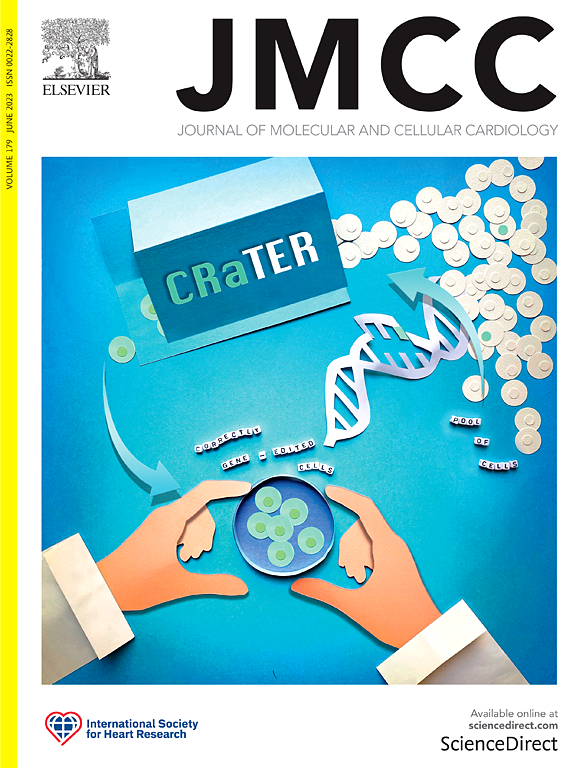基于群体的计算模拟阐明了干细胞注射后局灶性心律失常的机制
IF 4.7
2区 医学
Q1 CARDIAC & CARDIOVASCULAR SYSTEMS
引用次数: 0
摘要
心肌梗死(MI)后,大部分心室细胞被瘢痕取代,导致不良的结构重塑和心力衰竭。在心肌梗死后的动物模型中,使用干细胞衍生的心肌细胞显示出恢复心脏功能的希望,但会导致快速局灶性室性心动过速(VT)。这些动物的VT可能是可变的,其潜在机制尚不清楚。在这项研究中,我们使用了三种不同的计算模型,这些模型来源于心肌梗死后非人灵长类动物心室的组织学图像,以了解人类多能干细胞来源的心肌细胞(hPSC-CMs)移植物如何单独和协同地影响局灶性VT。具体来说,我们探讨了移植物是否可以协同产生新的心律失常,以及移植物弯曲度、面积、宿主隔离和周围疤痕数量等几何特征是否抑制或增强了这种效果。我们观察到至少一例移植物-宿主兴奋(GHE)的25个单个移植物中的11个检查。由于我们使用基于随机种群模型的方法来生成接枝边界,我们发现具有GHE的构型数量因接枝而异。我们还从总体上研究了移植物,发现当所有移植物被纳入时,GHE的高患病率是由单个致心律失常移植物的组合引起的(即,致心律失常性的总体增加是由于移植物的互补性而不是移植物的协同性)。对移植物空间特征的进一步分析表明,致心律失常移植物往往位于宿主隔离程度较高的区域(即存活心肌与移植物细胞交叉的空间受限区域),移植物面积和扭曲度也较高。这些见解可以帮助设计新的注射方案,从而为患者带来更安全的治疗。本文章由计算机程序翻译,如有差异,请以英文原文为准。

Population-based computational simulations elucidate mechanisms of focal arrhythmia following stem cell injection
Following a myocardial infarction (MI), a large portion of ventricular cells are replaced by scar, leading to adverse structural remodeling and heart failure. The use of stem cell-derived cardiomyocytes has shown promise in restoring cardiac function in animal models following an MI but leads to rapid focal ventricular tachycardia (VT). The VT in these animals can be variable, and its underlying mechanisms remain unknown. In this study, we used three distinct computational models derived from histological images of post-MI non-human primate ventricles to understand how human pluripotent stem cell-derived cardiomyocytes (hPSC-CMs) grafts can affect focal VT individually and synergistically. Specifically, we explored whether grafts could work cooperatively to create new arrhythmia and if geometric features such as graft tortuosity, area, host isolation, and amount of surrounding scar inhibited or enhanced the effect. We observed at least one instance of graft-host excitation (GHE) for eleven of the twenty-five individual grafts examined. Since we used a stochastic population-of-models-based approach to generate graft boundaries, we found that the number of configurations with GHE varied from graft to graft. We also examined grafts in aggregate and found that the high prevalence of GHE when all grafts were included arose from combinations of individually arrhythmogenic grafts (i.e., the overall increase in arrhythmogenicity resulted from graft complementarity rather than graft cooperativity). Further analysis of graft spatial features showed that arrhythmogenic grafts tend to be in areas with high host isolation (i.e., spatially confined regions of surviving myocardium interdigitated with engrafted cells) and when graft area and tortuosity were also high. These insights can aid in the design of novel injection schemes that could result in safer therapy for patients.
求助全文
通过发布文献求助,成功后即可免费获取论文全文。
去求助
来源期刊
CiteScore
10.70
自引率
0.00%
发文量
171
审稿时长
42 days
期刊介绍:
The Journal of Molecular and Cellular Cardiology publishes work advancing knowledge of the mechanisms responsible for both normal and diseased cardiovascular function. To this end papers are published in all relevant areas. These include (but are not limited to): structural biology; genetics; proteomics; morphology; stem cells; molecular biology; metabolism; biophysics; bioengineering; computational modeling and systems analysis; electrophysiology; pharmacology and physiology. Papers are encouraged with both basic and translational approaches. The journal is directed not only to basic scientists but also to clinical cardiologists who wish to follow the rapidly advancing frontiers of basic knowledge of the heart and circulation.

 求助内容:
求助内容: 应助结果提醒方式:
应助结果提醒方式:


